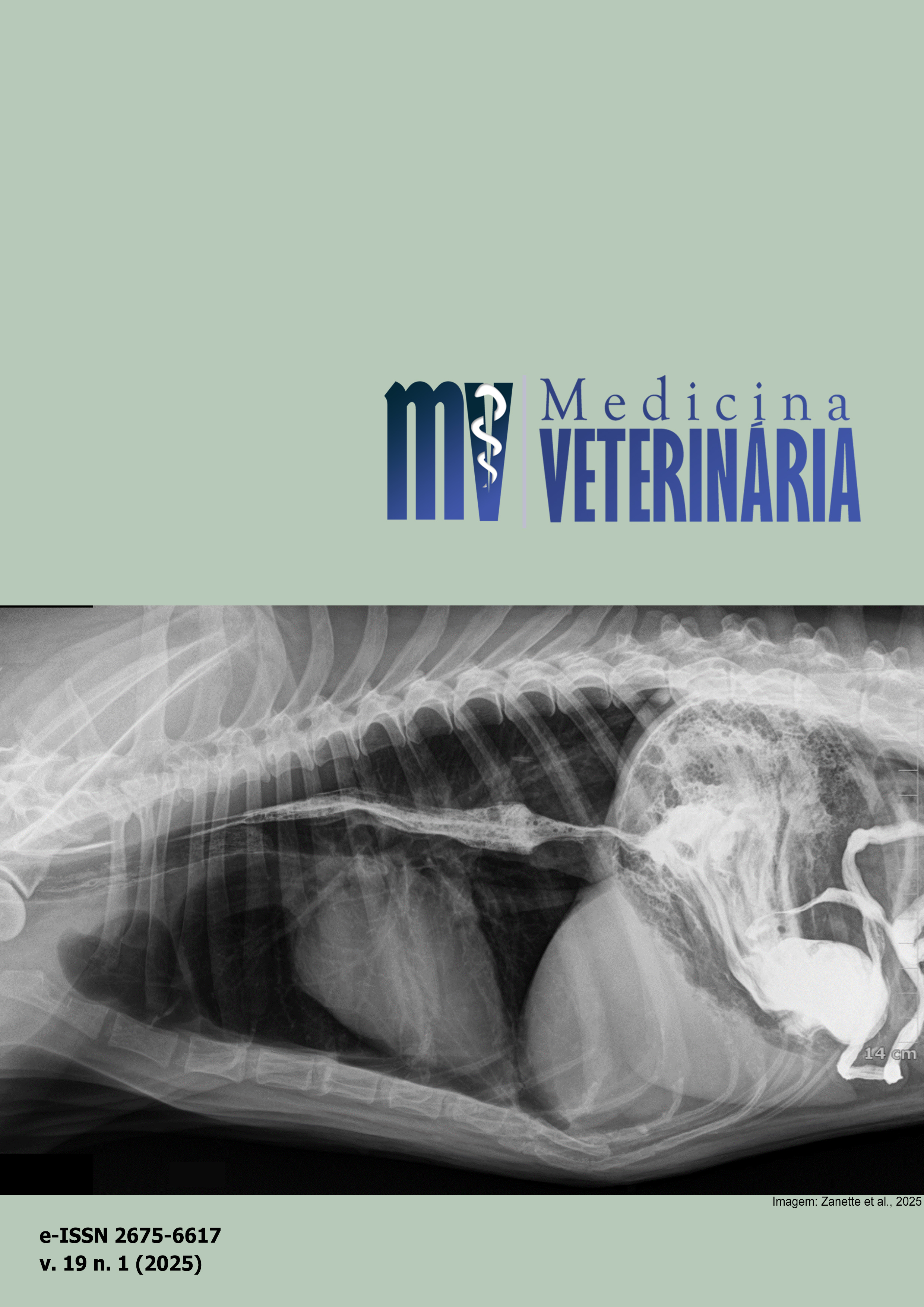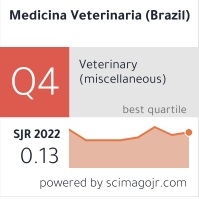Spatial assessment of the effects of deforestation, wildfire, and drought on the incidence of rabies in herbivores in the state of Maranhão, Brazil
DOI:
https://doi.org/10.26605/medvet-v19n1-6936Keywords:
zoonosis, epidemiology, prevention, wild mammalsAbstract
This study aimed to analyze the effects of the frequency and intensity of fires, as well as variations in the land surface covered by water, on the incidence of animal rabies. It sought to contribute to the improvement of control and prevention strategies for the disease. The analysis was based on cases of rabies reported in cattle and horses in the state of Maranhão, from 2006 to 2022, using the state's geographical microregions as study units. The relationship between the variables was analyzed using Poisson regression and the Local Bivariate Moran's Index. The results indicated a higher incidence of animal rabies in the northern part of the state, where there are lower livestock densities. It was observed that an increase in fire frequency and greater deforestation are associated with a reduction in rabies incidence, suggesting that the impact of these variables on the habitat of the main vectors has a positive effect on the migratory population dynamics of these animals and on the spread of the rabies virus. Additionally, the loss of water surface showed a positive correlation with the virus incidence, indicating that drought might be related to internal migration, closer proximity, and increased interaction among the disease's transmitter populations. The study proved effective in estimating the risk of occurrence and spread of rabies in the state, recommending the inclusion of measures to mitigate the environmental impacts caused by fires in rabies control and prevention strategies.Downloads
References
Anselin, L. Local indicators of spatial association—LISA. Geographical Analysis, 27: 93–115, 1995.
Anselin, L.; Syabri, I.; Kho, Y. GeoDa: an introduction to spatial data analysis. Geographical Analysis, 38: 5–22, 2006.
Auchincloss, A.H. et al. A review of spatial methods in epidemiology, 2000-2010. Annual Review of Public Health, 33: 107-122, 2012.
Baumont, C.; Ertur, C.; Le Gallo, J. Spatial analysis of employment and population density: The case of the agglomeration of Dijon 1999. Geographical Analysis, 36: 146-176, 2004.
Benavides, J.A. et al. Spatial expansions and travelling waves of rabies in vampire bats. The Royal Society, 283: 20160328, 2016.
Benavides, J.A. et al. Defining new pathways to manage the ongoing emergence of bat rabies in Latin America. Viruses, 12: 1002, 2020.
Blakey, R.V. et al. Bats in a changing landscape: linking occupancy and traits of a diverse montane bat community to fire regime. Ecology and Evolution, 9: 5324-5337, 2019.
BRASIL. Ministério da Agricultura, Pecuária e Abastecimento. Controle da raiva dos herbívoros: manual técnico. Brasília: MAPA/ACS, 2009. 124 p. Disponível em: < Disponível em: <https://www.gov.br/agricultura/pt-br/assuntos/sanidade-animal-e-vegetal/saude-animal/programas-de-saude-animal/raiva-dos-herbivoros-e-eeb/cartazes/manual_raiva-herbivoros-2009.pdf/view>. Acesso em: 28 fev. 2025.
BRASIL. Departamento de Saúde Animal e Insumos Pecuários. Raiva dos herbívoros. Ficha técnica. Abril 2020. Disponível em: <https://sistemasweb.agricultura.gov.br/pages/fichas_tecnicas/ficha_tecnica.html>. Acesso em: 02 out. 2024.
BRASIL. Ministério da Agricultura e Pecuária. Sistema Nacional de Informação Zoossanitária. 2024. Disponível em: <https://mapa-indicadores.agricultura.gov.br/publico/extensions/Saude_animal/Saude_animal.html>. Acesso em: 01 out. 2024.
Cabral, C. et al. Circulation of the rabies virus in non-hematophagous bats in the city of Rio de Janeiro, Brazil, during 2001-2010. Revista da Sociedade Brasileira de Medicina Tropical, 45(2): 180-183, 2012.
Ellwanger, J.H. et al. Beyond diversity loss and climate change: impacts of Amazon deforestation on infectious diseases and public health. Anais da Academia Brasileira de Ciências, 92(1): e20191375, 2020.
Gomes, M.N.; Monteiro, A.M.V. Raiva bovina no estado de São Paulo e sua distribuição espacial entre 1992 e 2003. Arquivos Brasileiros de Medicina Veterinária e Zootecnia, 63(2): 279-286, 2011.
Govender, N. et al. The effect of fire season, fire frequency, rainfall, and management on fire intensity in savanna vegetation in South Africa. Journal of Applied Ecology, 43: 748–758, 2006.
Harper, A.R. et al. Prescribed fire and its impacts on ecosystem services in the UK. Science of The Total Environment, 624: 691–703, 2018.
IBGE. Instituto Brasileiro de Geografia e Estatística. Divisão regional do Brasil em regiões geográficas imediatas e regiões geográficas intermediárias. Brasília: IBGE, 2017. Disponível em: https://www.ibge.gov.br/geociencias/cartas-e-mapas/redes-geograficas/15778-divisoes-regionais-do-brasil.html. Acesso em 01 out. 2024.
IBGE. Brasileiro de Geografia e Estatística. Pesquisa da Pecuária Municipal. Brasília: IBGE, 2023. Disponível em: https://www.ibge.gov.br/estatisticas/economicas/agricultura-e-pecuaria/9107-producao-da-pecuaria-municipal.html. Acesso em: 05 jan. 2024.
INPE. Instituto Nacional de Pesquisas Espaciais. BDQueimadas. São Paulo. São José dos Campos: INPE, 2023. Disponível em: <https://terrabrasilis.dpi.inpe.br/queimadas/portal/>. Acesso em 03 out. 2024.
Johnson, N.; Aréchiga-Ceballos, N.; Aguilar-Setien, A. Vampire bat rabies: ecology, epidemiology and control. Viruses, 6(5):1911-1928, 2014.
MARANHÃO. Agência de Defesa Agropecuária do Estado do Maranhão. Ofício 1288/22/GAB/AGED/MA. Casos de Raiva em herbívoros, ocorridos no Maranhão, no período de 2006 a 2022. São Luís, 10 de novembro de 2022.
Maravalhas, J.; Vasconcelos, H.L. Revisiting the pyrodiversity-biodiversity hypothesis: long-term fire regimes and the structure of ant communities in a Neotropical savanna hotspot. Journal of Applied Ecology, 51: 1661–1668, 2014.
Meza, D.K. et al. Ecological determinants of rabies virus dynamics in vampire bats and spillover to livestock. Proceedings of the Royal Society B, 289: número de páginas, 2022.
Mantovan, K.; Menozzi, B.; Paiz, L.; Sevá, A.; Brandão, P.; Langoni, H. Geographic distribution of common vampire bat Desmodus rotundus (Chiroptera: Phyllostomidae) shelters: implications for the spread of rabies virus to cattle in southeastern Brazil. Pathogens, 11(8): 942, 2022.
Moran, P.A.P. Maximum-likelihood estimation in non-standard conditions. Mathematical Proceedings of the Cambridge Philosophical Society, 70: 441–450, 1971.
Oliveira, U. et al. A near real-time web-system for predicting fire spread across the Cerrado biome. Scientific Reports, 13: 4829, 2023.
OMS. Organização Mundial da Saúde; OPAS. Organização Pan-Americana da Saúde. Programa Regional das Américas para Prevenção e Controle da Raiva Transmitida pelo Morcego Hematófago (D. rotundus) em Animais de Produção Suscetíveis. 2021. 36 p.
Ortega-Sánchez, R. et al. Spatial-temporal risk factors in the occurrence of rabies in Mexico. Geospatial Health, 19: 1245, 2024.
Pfeiffer, D.U. et al. Spatial Analysis in Epidemiology. Online edn. Oxford: Oxford Academic, 2008. 142p.https://academic.oup.com/book/1991.
Projeto MapBiomas. Mapeamento de cicatrizes de fogo no Brasil, Coleção 3, São Paulo, Brasil. 2023a. Disponível em: <https://brasil.mapbiomas.org/estatisticas/> Acesso em 05 jan. 2024.
Projeto MapBiomas. Coleção 2. Superfície de Água. Mapbiomas água. São Paulo, Brasil 2023b. Disponível em: <https://brasil.mapbiomas.org/estatisticas/> Acesso em 05 jan. 2023.
Projeto MapBiomas. Coleção 8. Relatório Anual de Desmatamento 2022. São Paulo, Brasil. 2023c. Disponível em: <https://brasil.mapbiomas.org/estatisticas/> Acesso em 05 jan. 2023.
Rocha, S.; Oliveira, S.; Heinemann, M.; Gonçalves, V. Epidemiological Profile of Wild Rabies in Brazil (2002–2012). Transboundary and Emerging Diseases, 64: 624–633, 2017.
Rocha, F. et al. Relations between topography, feeding sites, and foraging behavior of the vampire bat, Desmodus rotundus. Journal of Mammalogy, 101: 164–171, 2019.
Silva, L.J.; Angerami, R.N. Viroses emergentes no Brasil. Rio de Janeiro: Editora Fiocruz, 2008. 23p.
Souza, L.C. et al. Vigilância epidemiológica da raiva na região de Botucatu-SP: importância dos quirópteros na manutenção do vírus na natureza. Ars Veterinaria, 21: 062-068, 2005.
Schmidt, I.B.; Eloy, L. Fire regime in the Brazilian Savanna: recent changes, policy and management. Flora, 268: 151613, 2020.
Steel, Z.L. et al. The effects of wildfire severity and pyrodiversity on bat occupancy and diversity in fire-suppressed forests. Scientific Reports, 9: 16300, 2019.
Stephens, S.L. et al. Temperate and boreal forest mega-fires: characteristics and challenges. Frontiers in Ecology and the Environment, 12: 115-122, 2014.
Streicker, D.G. et al. Ecological and anthropogenic drivers of rabies exposure in vampire bats: implications for transmission and control. Proceedings of the Royal Society B: Biological Sciences, 279: 3384-3392, 2012.
Travis-Lumer, Y. et al. Effect size quantification for interrupted time series analysis: implementation in R and analysis Covid-19 research. Emerging Themes in Epidemiology, 19: 9, 2022.
Ulloa-Stanojlovic, F.M.; Dias, R.A. Spatio-temporal description of bovine rabies cases in Peru, 2003-2017. Transboundary and Emerging Diseases, 67(1688-96): 1688-1696, 2020.
Waller, L.A. et al. The geography of power: statistical performance of tests of clusters and clustering in heterogeneous populations. Statistics in Medicine, 25: 853–865, 2006.
Vergopolan, N.; Fisher, J.B. The impact of deforestation on the hydrological cycle in Amazonia as observed from remote sensing. International Journal of Remote Sensing, 37(22): 5412–5430, 2016.
Downloads
Published
How to Cite
Issue
Section
License
Copyright (c) 2025 José Wendel Araújo Soares, Maria do Socorro Costa Oliveira

This work is licensed under a Creative Commons Attribution-NonCommercial-ShareAlike 4.0 International License.
A Revista de Medicina Veterinária permite que o autor retenha os direitos de publicação sem restrições, utilizando para tal a licença Creative Commons CC BY-NC-SA 4.0.
De acordo com os termos seguintes:
Atribuição — Você deve dar o crédito apropriado, prover um link para a licença e indicar se mudanças foram feitas. Você deve fazê-lo em qualquer circunstância razoável, mas de nenhuma maneira que sugira que o licenciante apoia você ou o seu uso.
NãoComercial — Você não pode usar o material para fins comerciais.
CompartilhaIgual — Se você remixar, transformar, ou criar a partir do material, tem de distribuir as suas contribuições sob a mesma licença que o original.
Sem restrições adicionais — Você não pode aplicar termos jurídicos ou medidas de caráter tecnológico que restrinjam legalmente outros de fazerem algo que a licença permita.







